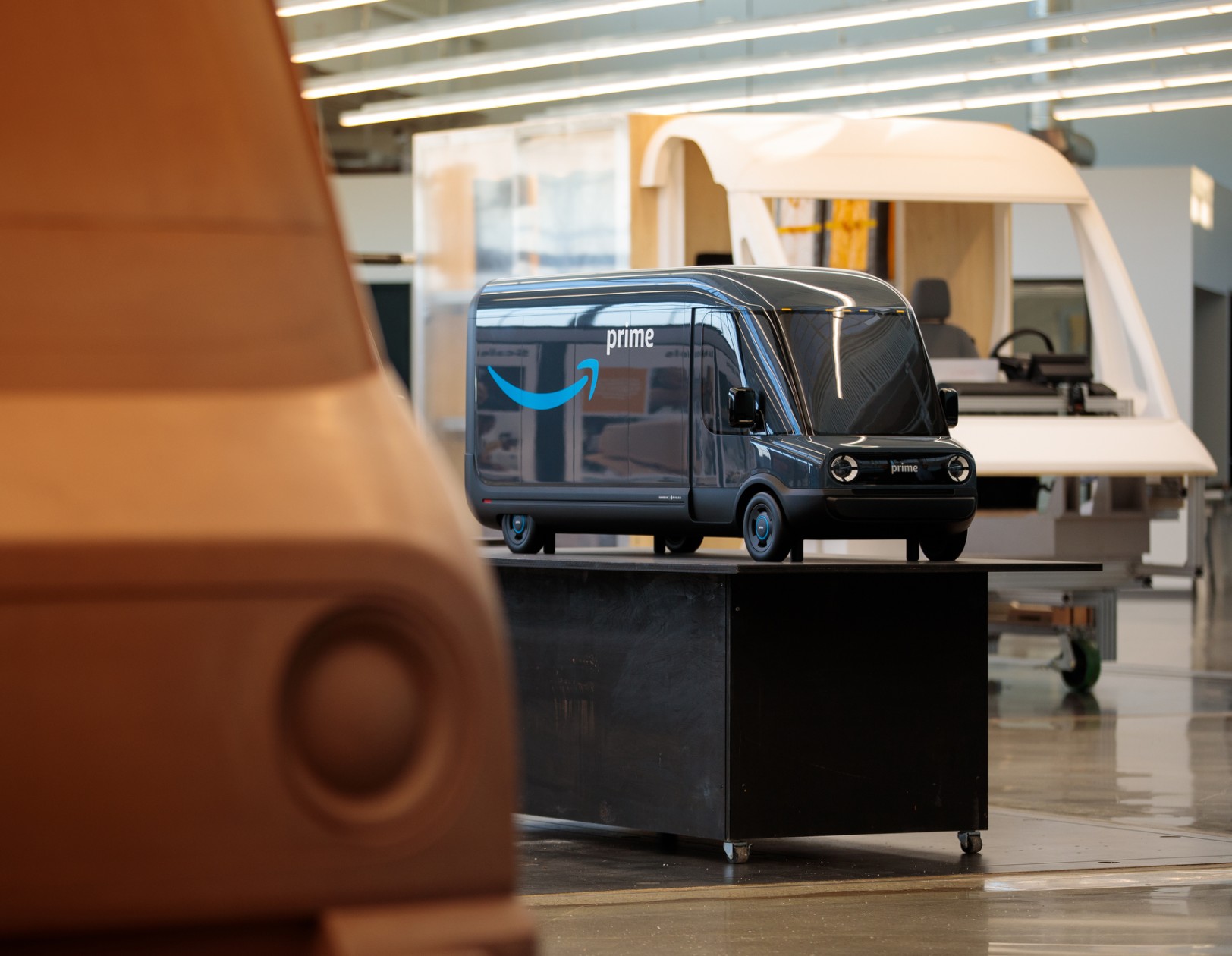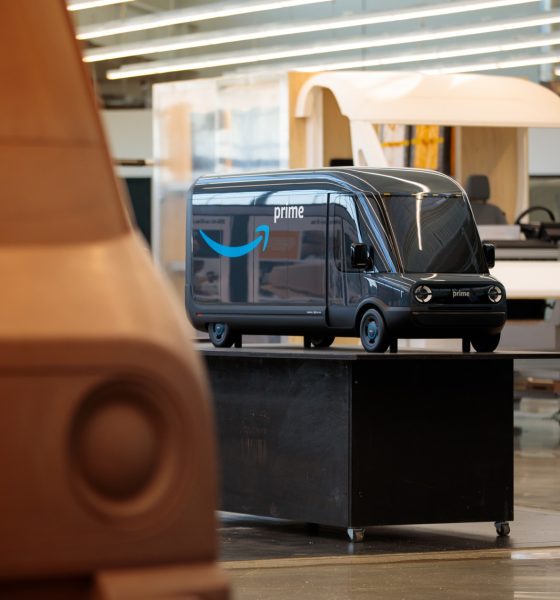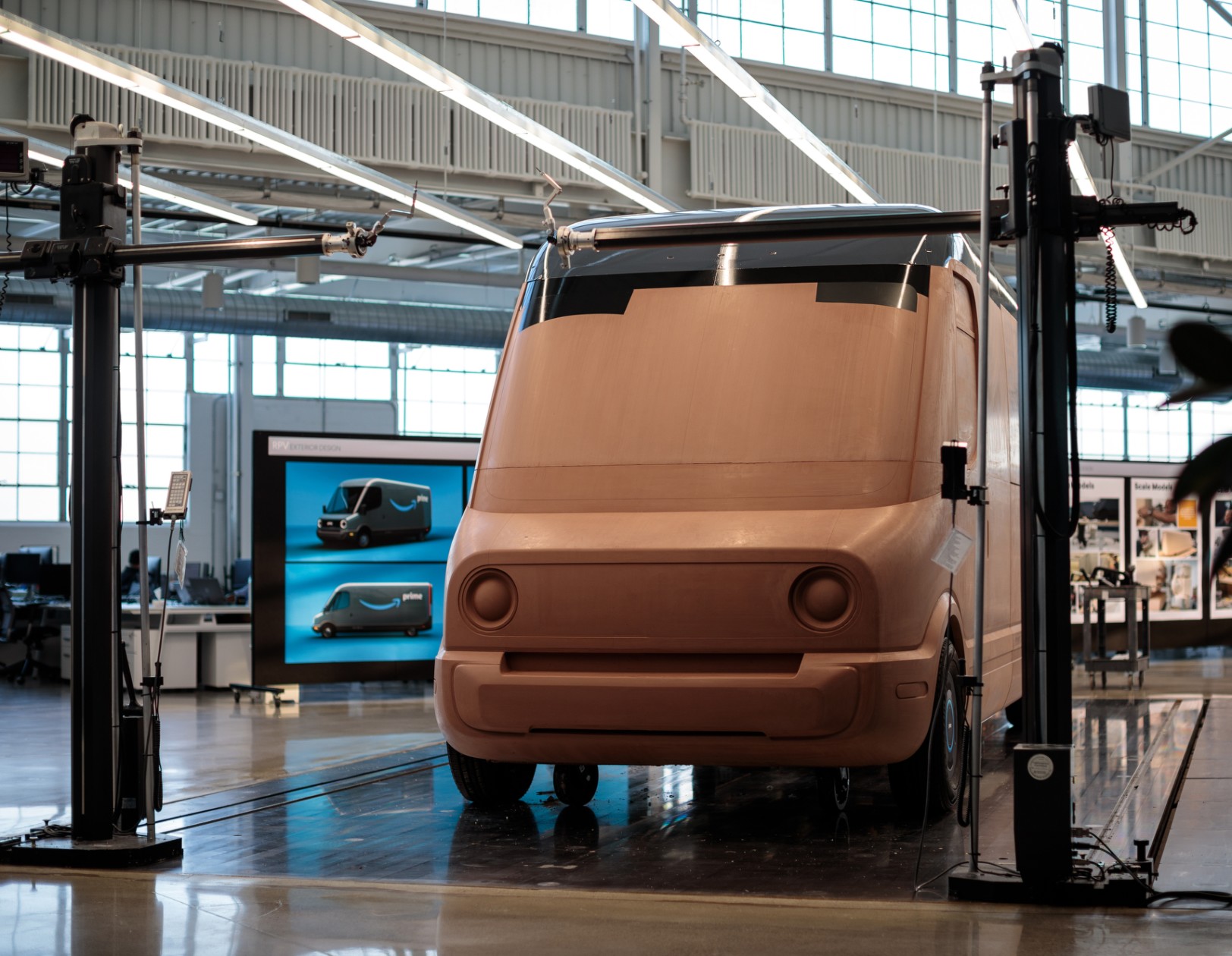

News
Amazon reveals design of its Rivian-powered electric delivery van
Amazon has revealed the design of its upcoming all-electric delivery vehicle, produced in partnership with Rivian.
The $1 trillion dollar e-commerce giant has taken the wraps off a life-size clay model and a small-scale model of its planned delivery van. Unsurprisingly, the all-electric vehicle looks very similar to the current Amazon Prime delivery vans, but with slightly rounded design cues and improved ergonomics and safety features.
Last year, Amazon announced that it has teamed up with electric truck startup Rivian to produce a massive 100,000-unit fleet of electric delivery vans. Amazon says it spent 18 months analyzing electric delivery truck options on the market until it decided to build its own custom van designed specifically for its delivery business.
The latest development reveals how far the Amazon-Rivian partnership has gone toward meeting Amazon’s goal of sending the first of the 100,000 vans delivering packages to American homes by 2021. Amazon hopes to get 10,000 of its electric vans deployed by 2022 and all 100,000 by the end of the decade.
Both the small-scale and life-size clay models were designed at the Rivian headquarters in Plymouth, Michigan, where rows of design boards featuring numerous versions of the Amazon delivery van fill an entire side of the studio.

In another room, Rivian has put together a virtual reality simulation setup to allow drivers to test the new driving experience and offer suggestions for improvement. Amazon says it has consulted heavily with its drivers in working on the truck’s final design, considering certain factors such as loading and unloading of packages, ease of getting in and out of the van, and seat comfort.
“We’re focused on driving efficiency into every aspect of the vehicle design—everything from cabin heating to driver ergonomics to drivetrain design has been optimized for time and energy,” says Rivian CEO RJ Scaringe.
Amazon says the van will be in three sizes with multiple battery configurations to suit various delivery routes. It will come with front-wheel and all-wheel driving options for different terrains and a variety of safety technologies, including automated emergency brakes, lane-keep assist, and a pedestrian warning system. The dashboard will include Amazon’s logistics management system and will provide drivers with the most efficient routes for delivery. It will also integrate Alexa to allow drivers to make hands-free voice commands.
Amazon’s plan to build its own fleet of electric delivery vans is part of its Climate Pledge, a commitment to meet the Paris Agreement in 10 years.
“When we succeed, if we displace those gasoline vehicles with electric vehicles, it will be a large step forward in making our package delivery business sustainable and it has a positive impact on the environment,” says Ross Rachey, director of global last-mile at Amazon.
Amazon is not the only major company that has partnered with Rivian. In January, Ford announced that it is working with Rivian to produce the first electric truck for its Lincoln luxury brand. The startup is also gearing up to release two of its own electric vehicles, the R1T pickup truck, and the R1S SUV, both of which are built on Rivian’s flat-frame skateboard platform. Both vehicles will also come integrated with Alexa.

News
Tesla starts showing how FSD will change lives in Europe
Local officials tested the system on narrow country roads and were impressed by FSD’s smooth, human-like driving, with some calling the service a game-changer for everyday life in areas that are far from urban centers.

Tesla has launched Europe’s first public shuttle service using Full Self-Driving (Supervised) in the rural Eifelkreis Bitburg-Prüm region of Germany, demonstrating how the technology can restore independence and mobility for people who struggle with limited transport options.
Local officials tested the system on narrow country roads and were impressed by FSD’s smooth, human-like driving, with some calling the service a game-changer for everyday life in areas that are far from urban centers.
Officials see real impact on rural residents
Arzfeld Mayor Johannes Kuhl and District Administrator Andreas Kruppert personally tested the Tesla shuttle service. This allowed them to see just how well FSD navigated winding lanes and rural roads confidently. Kruppert said, “Autonomous driving sounds like science fiction to many, but we simply see here that it works totally well in rural regions too.” Kuhl, for his part, also noted that FSD “feels like a very experienced driver.”
The pilot complements the area’s “Citizen Bus” program, which provides on-demand rides for elderly residents who can no longer drive themselves. Tesla Europe shared a video of a demonstration of the service, highlighting how FSD gives people their freedom back, even in places where public transport is not as prevalent.
What the Ministry for Economic Affairs and Transport says
Rhineland-Palatinate’s Minister Daniela Schmitt supported the project, praising the collaboration that made this “first of its kind in Europe” possible. As per the ministry, the rural rollout for the service shows FSD’s potential beyond major cities, and it delivers tangible benefits like grocery runs, doctor visits, and social connections for isolated residents.
“Reliable and flexible mobility is especially vital in rural areas. With the launch of a shuttle service using self-driving vehicles (FSD supervised) by Tesla in the Eifelkreis Bitburg-Prüm, an innovative pilot project is now getting underway that complements local community bus services. It is the first project of its kind in Europe.
“The result is a real gain for rural mobility: greater accessibility, more flexibility and tangible benefits for everyday life. A strong signal for innovation, cooperation and future-oriented mobility beyond urban centers,” the ministry wrote in a LinkedIn post.
News
Tesla China quietly posts Robotaxi-related job listing
Tesla China is currently seeking a Low Voltage Electrical Engineer to work on circuit board design for the company’s autonomous vehicles.

Tesla has posted a new job listing in Shanghai explicitly tied to its Robotaxi program, fueling speculation that the company is preparing to launch its dedicated autonomous ride-hailing service in China.
As noted in the listing, Tesla China is currently seeking a Low Voltage Electrical Engineer to work on circuit board design for the company’s autonomous vehicles.
Robotaxi-specific role
The listing, which was shared on social media platform X by industry watcher @tslaming, suggested that Tesla China is looking to fill the role urgently. The job listing itself specifically mentions that the person hired for the role will be working on the Low Voltage Hardware team, which would design the circuit boards that would serve as the nervous system of the Robotaxi.
Key tasks for the role, as indicated in the job listing, include collaboration with PCB layout, firmware, mechanical, program management, and validation teams, among other responsibilities. The role is based in Shanghai.
China Robotaxi launch
China represents a massive potential market for robotaxis, with its dense urban centers and supportive policies in select cities. Tesla has limited permission to roll out FSD in the country, though despite this, its vehicles have been hailed as among the best in the market when it comes to autonomous features. So far, at least, it appears that China supports Tesla’s FSD and Robotaxi rollout.
This was hinted at in November, when Tesla brought the Cybercab to the 8th China International Import Expo (CIIE) in Shanghai, marking the first time that the autonomous two-seater was brought to the Asia-Pacific region. The vehicle, despite not having a release date in China, received a significant amount of interest among the event’s attendees.
Elon Musk
Elon Musk and Tesla AI Director share insights after empty driver seat Robotaxi rides
The executives’ unoccupied tests hint at the rapid progress of Tesla’s unsupervised Robotaxi efforts.

Tesla CEO Elon Musk and AI Director Ashok Elluswamy celebrated Christmas Eve by sharing personal experiences with Robotaxi vehicles that had no safety monitor or occupant in the driver’s seat. Musk described the system’s “perfect driving” around Austin, while Elluswamy posted video from the back seat, calling it “an amazing experience.”
The executives’ unoccupied tests hint at the rapid progress of Tesla’s unsupervised Robotaxi efforts.
Elon and Ashok’s firsthand Robotaxi insights
Prior to Musk and the Tesla AI Director’s posts, sightings of unmanned Teslas navigating public roads were widely shared on social media. One such vehicle was spotted in Austin, Texas, which Elon Musk acknowleged by stating that “Testing is underway with no occupants in the car.”
Based on his Christmas Eve post, Musk seemed to have tested an unmanned Tesla himself. “A Tesla with no safety monitor in the car and me sitting in the passenger seat took me all around Austin on Sunday with perfect driving,” Musk wrote in his post.
Elluswamy responded with a 2-minute video showing himself in the rear of an unmanned Tesla. The video featured the vehicle’s empty front seats, as well as its smooth handling through real-world traffic. He captioned his video with the words, “It’s an amazing experience!”
Towards Unsupervised operations
During an xAI Hackathon earlier this month, Elon Musk mentioned that Tesla owed be removing Safety Monitors from its Robotaxis in Austin in just three weeks. “Unsupervised is pretty much solved at this point. So there will be Tesla Robotaxis operating in Austin with no one in them. Not even anyone in the passenger seat in about three weeks,” he said. Musk echoed similar estimates at the 2025 Annual Shareholder Meeting and the Q3 2025 earnings call.
Considering the insights that were posted Musk and Elluswamy, it does appear that Tesla is working hard towards operating its Robotaxis with no safety monitors. This is quite impressive considering that the service was launched just earlier this year.








